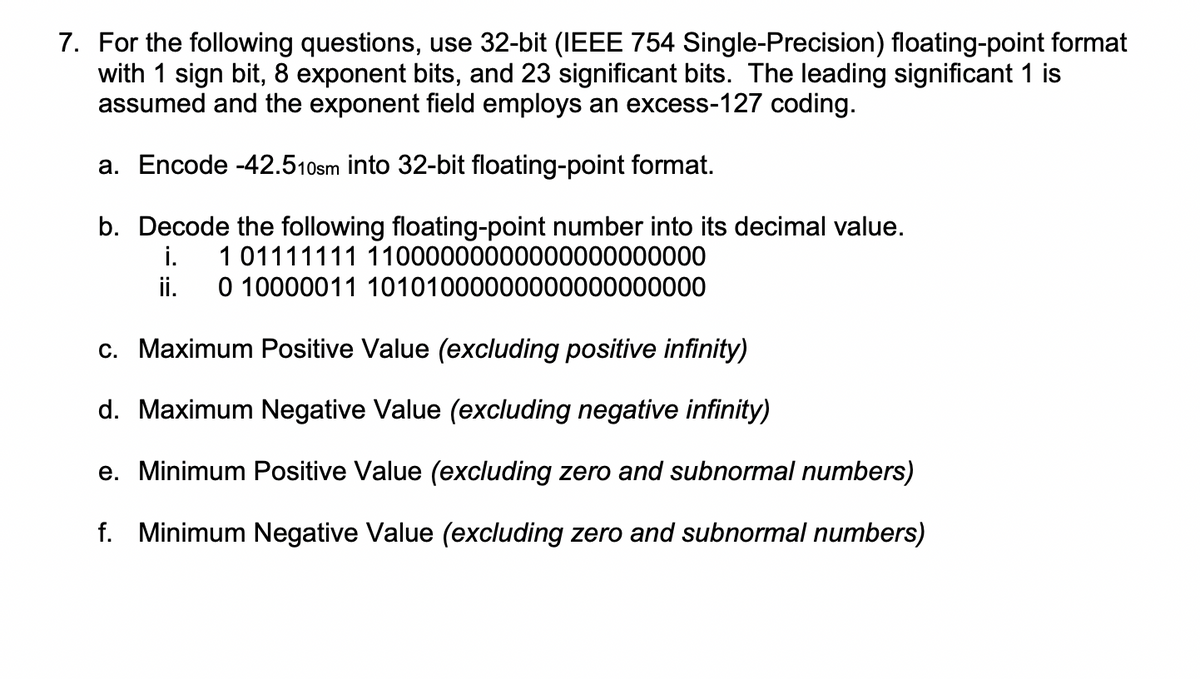7. For the following questions, use 32-bit (IEEE 754 Single-Precision) floating-point format with 1 sign bit, 8 exponent bits, and 23 significant bits. The leading significant 1 is assumed and the exponent field employs an excess-127 coding. a. Encode -42.510sm into 32-bit floating-point format. b. Decode the following floating-point number into its decimal value. i. 0 10000011 10101000000000000000000 1 01111111 11000000000000000000000 ii.
7. For the following questions, use 32-bit (IEEE 754 Single-Precision) floating-point format with 1 sign bit, 8 exponent bits, and 23 significant bits. The leading significant 1 is assumed and the exponent field employs an excess-127 coding. a. Encode -42.510sm into 32-bit floating-point format. b. Decode the following floating-point number into its decimal value. i. 0 10000011 10101000000000000000000 1 01111111 11000000000000000000000 ii.
Computer Networking: A Top-Down Approach (7th Edition)
7th Edition
ISBN:9780133594140
Author:James Kurose, Keith Ross
Publisher:James Kurose, Keith Ross
Chapter1: Computer Networks And The Internet
Section: Chapter Questions
Problem R1RQ: What is the difference between a host and an end system? List several different types of end...
Related questions
Question
provide steps

Transcribed Image Text:7. For the following questions, use 32-bit (IEEE 754 Single-Precision) floating-point format
with 1 sign bit, 8 exponent bits, and 23 significant bits. The leading significant 1 is
assumed and the exponent field employs an excess-127 coding.
a. Encode -42.510sm into 32-bit floating-point format.
b. Decode the following floating-point number into its decimal value.
i.
0 10000011 10101000000000000000000
1 01111111 11000000000000000000000
ii.
c. Maximum Positive Value (excluding positive infinity)
d. Maximum Negative Value (excluding negative infinity)
e. Minimum Positive Value (excluding zero and subnormal numbers)
f. Minimum Negative Value (excluding zero and subnormal numbers)
Expert Solution
This question has been solved!
Explore an expertly crafted, step-by-step solution for a thorough understanding of key concepts.
This is a popular solution!
Trending now
This is a popular solution!
Step by step
Solved in 2 steps with 2 images

Recommended textbooks for you

Computer Networking: A Top-Down Approach (7th Edi…
Computer Engineering
ISBN:
9780133594140
Author:
James Kurose, Keith Ross
Publisher:
PEARSON

Computer Organization and Design MIPS Edition, Fi…
Computer Engineering
ISBN:
9780124077263
Author:
David A. Patterson, John L. Hennessy
Publisher:
Elsevier Science

Network+ Guide to Networks (MindTap Course List)
Computer Engineering
ISBN:
9781337569330
Author:
Jill West, Tamara Dean, Jean Andrews
Publisher:
Cengage Learning

Computer Networking: A Top-Down Approach (7th Edi…
Computer Engineering
ISBN:
9780133594140
Author:
James Kurose, Keith Ross
Publisher:
PEARSON

Computer Organization and Design MIPS Edition, Fi…
Computer Engineering
ISBN:
9780124077263
Author:
David A. Patterson, John L. Hennessy
Publisher:
Elsevier Science

Network+ Guide to Networks (MindTap Course List)
Computer Engineering
ISBN:
9781337569330
Author:
Jill West, Tamara Dean, Jean Andrews
Publisher:
Cengage Learning

Concepts of Database Management
Computer Engineering
ISBN:
9781337093422
Author:
Joy L. Starks, Philip J. Pratt, Mary Z. Last
Publisher:
Cengage Learning

Prelude to Programming
Computer Engineering
ISBN:
9780133750423
Author:
VENIT, Stewart
Publisher:
Pearson Education

Sc Business Data Communications and Networking, T…
Computer Engineering
ISBN:
9781119368830
Author:
FITZGERALD
Publisher:
WILEY